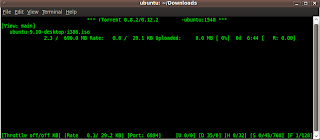Technical details
The library differentiates itself from other implementations by transferring data directly between file pages mapped to memory by the mmap() function and the network stack. On high-bandwidth connections, it claims to be able to seed at 3 times the speed of the official client.
rTorrent packages are available for various Linux distributions and Unix-like systems, and it will compile and run on nearly every POSIX-compliant operating system, such as FreeBSD and Mac OS X.
rTorrent uses ncurses and is suitable for use with screen; it uses commands such as Carriage return to load a torrent, after which ^S can be used to start a torrent (where ^ is shorthand for Ctrl key), Backspace can be used to automatically start a torrent once it is loaded, making a subsequent issue of ^S unnecessary, ^K for stop, and ^D for pause, or if already paused or stopped, ^D again to delete the torrent. It supports saving of sessions and allows the user to add and remove torrents. It also supports partial downloading of multi-file torrents. In the release of rTorrent-0.7.0 support for BitTorrent protocol encryption was also implemented. PEX, DHT and initial seeding were recently implemented in rTorrent.
rTorrent can be controlled via XML-RPC over SCGI.
- wTorrent - a WebUI for rTorrent
- ruTorrent - a WebUI for rTorrent, similar to μTorrent's WebUI
- nTorrent - a rTorrent GUI for Linux, Mac and Windows users
- Nativa - rTorrent GUI for Mac users, similar to Transmission's GUI
